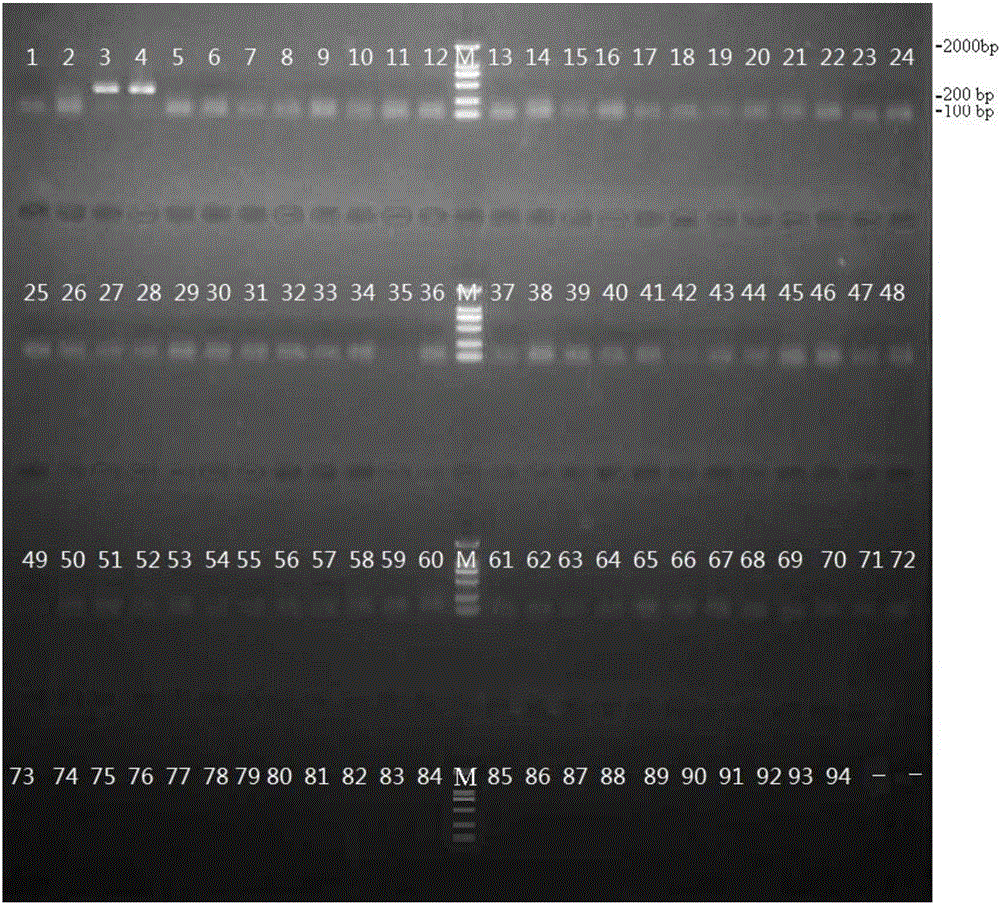Vigna radiata specific PCR (polymerase chain reaction) primer pair and method for detecting vigna radiata in phytophagous insect bodies
A primer pair and specificity technology, which is applied in the field of mung bean-specific PCR primer pair and its detection in herbivorous insects, can solve the problems of difficult success, high cost, and laboriousness, and achieve high accuracy, high sensitivity, and easy operation. simple effect
- Summary
- Abstract
- Description
- Claims
- Application Information
AI Technical Summary
Problems solved by technology
Method used
Image
Examples
Embodiment 1
[0025] The amplification effect of specific primer LraF1 / LraR1 of embodiment 1 to mung bean
[0026] 1. Preparation of mung bean genomic DNA
[0027] The mung bean leaves were ground in a mortar, and the mung bean genome was extracted with the DNAquick Plant System Quick Plant Genomic DNA Extraction Kit (non-spin column type) (Tiangen Company). The DNA solution was stored at -20°C for later use, and 1 μL of the solution was taken as a DNA template during PCR amplification.
[0028] 2. Synthesis of specific primers for mung bean detection
[0029] According to the mung bean rbcL sequence (AP014692.1) published in GenBank, the following specific PCR primer pairs were designed:
[0030] LraF1: 5'-TCACATCGAACCTGTTCCTGGG-3' (SeqIDNo.1)
[0031] LraR1: 5'-CCACCACGAAGACATTCATAAA-3' (SeqIDNo.2)
[0032] 3. PCR amplification
[0033] Reaction system 20μL:
[0034]
[0035] PCR amplification program: 95°C pre-denaturation for 10 minutes; 95°C for 30 seconds, 58°C for 30 seconds...
Embodiment 2
[0045] Example 2 Primer LraF1 / LraR1 Determination of Mung Bean Minimum Detection Amount
[0046] 1. For the preparation of the mung bean template genome, refer to step 1 in Example 1.
[0047] 2) Preparation of mung bean plasmid
[0048] The mung bean genomic DNA was amplified according to the method in step 3 in Example 1, and detected by 1.5% agarose gel electrophoresis after the amplification was completed. Use the Axygen Agarose Gel DNA Purification Kit to recover the PCR product, the PCR product is cloned on the pEasy-T3 vector after being recovered by gel (operate according to the kit instructions), the recombinant plasmid is transformed into Trans1-T1 competent cells, and then spread on the medium containing Ampicillin / X-gal / IPTG LB plates were cultured upside down at 37°C for 15 hours. After blue-white screening, 10 positive clones were picked and cultured overnight in LB liquid medium containing Amp, and the next day, the plasmid was extracted with the Axygen plasmi...
Embodiment 3
[0050] Example 3 Using primers LraF1 / LraR1 to detect trace amounts of mung beans in insects
[0051] 1. Starvation treatment of 10 Lygus green bugs for 24 hours, feeding with mung bean leaves for 3 hours, and immediately killing them by freezing with liquid nitrogen.
[0052] / 2. Put the single-headed Lygus chinensis in a 1.5ml centrifuge tube and grind it, and extract DNA by CTAB method.
[0053]Add 40 μL of PBS (150 mM NaCl, 150 mM NaCl, 3 PO 4 , pH7.2,), followed by adding 450 μL of TES buffer (0.1MTris, pH8, 10mM EDTA, 2% SDS), 10 μL of proteinase K (10mg / ml) and 10mg of PVP, placed in a metal bath at 58°C for 12h. After taking it out from the metal bath, add 150 μL of 5M NaCl and 65 μL of 10% CTAB, place the sample in the metal bath at 65°C for 10 minutes, add chloroform / isoamyl alcohol (24:1) for extraction after taking it out, add 225 μL after standing still 5MNH 4 Ac, put it on ice for more than 30 minutes, take it out and centrifuge at 12000g for 20 minutes, disca...
PUM
 Login to View More
Login to View More Abstract
Description
Claims
Application Information
 Login to View More
Login to View More - R&D
- Intellectual Property
- Life Sciences
- Materials
- Tech Scout
- Unparalleled Data Quality
- Higher Quality Content
- 60% Fewer Hallucinations
Browse by: Latest US Patents, China's latest patents, Technical Efficacy Thesaurus, Application Domain, Technology Topic, Popular Technical Reports.
© 2025 PatSnap. All rights reserved.Legal|Privacy policy|Modern Slavery Act Transparency Statement|Sitemap|About US| Contact US: help@patsnap.com



